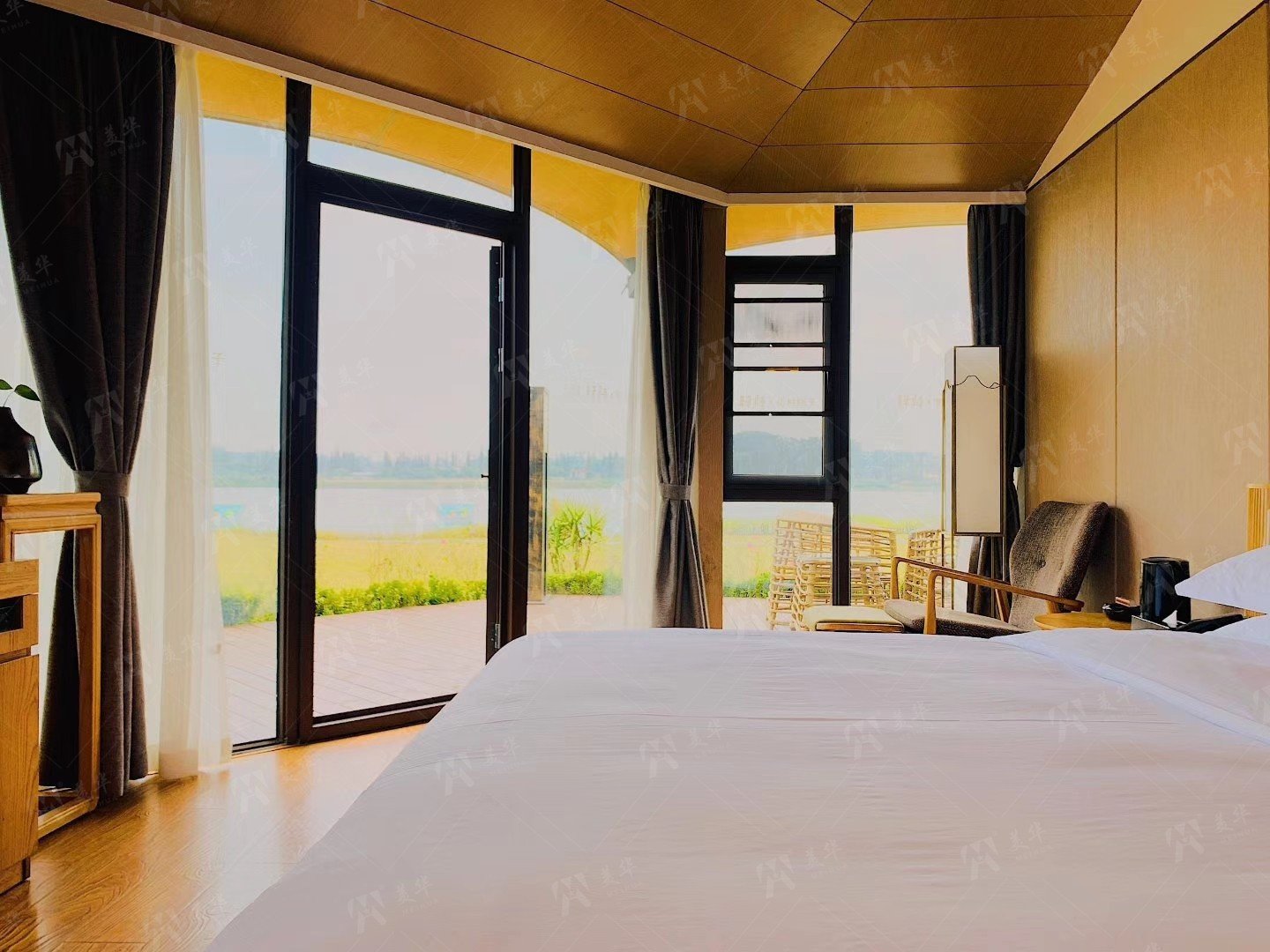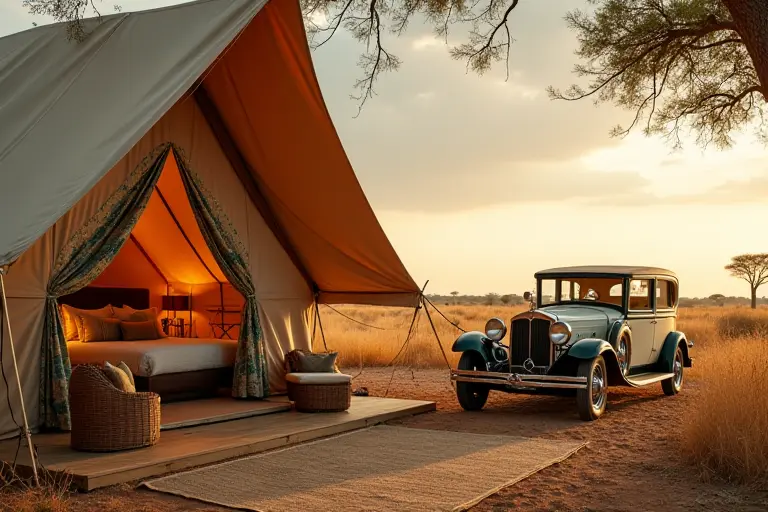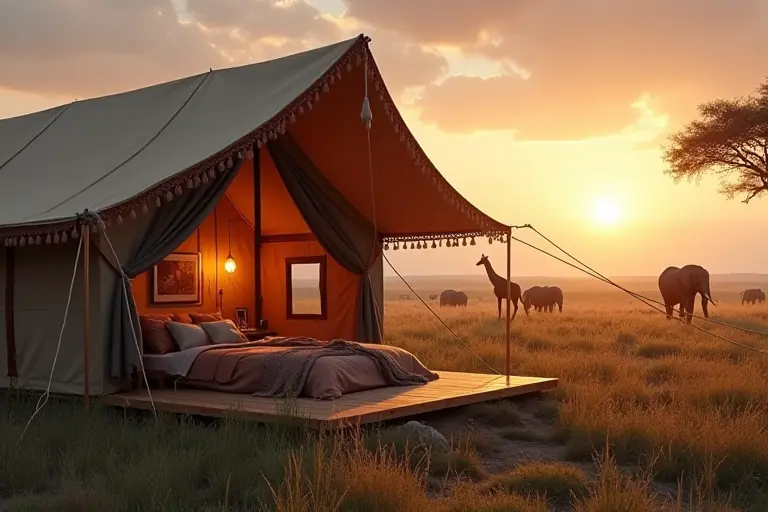Understanding Glamping and Market Research
Glamping, or glamorous camping, is a growing trend that combines the comfort and luxury of a hotel with the adventure and natural beauty of the great outdoors. If you’re wondering how to start a glamping business, conducting thorough market research is essential. This will help you understand your target market, identify your competition, and determine the potential demand for your services.
Identify Your Target Market
Start by defining who your ideal customers are. Are they families looking for a fun and safe outdoor experience? Couples seeking a romantic getaway? Adventure seekers craving unique experiences? Understanding your target market will help you tailor your glamping offerings to meet their needs and preferences.
Analyze Your Competition
Look at other glamping businesses in your area and beyond. What services do they offer? What are their prices? What makes them stand out? This analysis will help you identify gaps in the market that you can fill and differentiate your business when starting your glamping venture.
Determine Demand
Use surveys, social media, and local tourism data to gauge the interest in glamping in your area. This will give you a better idea of the potential customer base and help you make informed decisions about the size and scope of your business.
Real-World Example
Consider the success of “Luxury Wilderness Retreats,” a glamping business that identified a niche market of urban professionals seeking eco-friendly luxury experiences. By offering solar-powered yurts with high-end amenities in a secluded forest location, they’ve seen a 200% growth in bookings over the past two years.
Online Tools for Market Research
- SurveyMonkey: Create and distribute surveys to potential customers
- Google Trends: Analyze the popularity of glamping-related search terms
- Social media listening tools: Monitor conversations about glamping on platforms like Instagram and Twitter
By conducting comprehensive market research using these tools and strategies, you can ensure that your glamping business is well-positioned to succeed in a competitive and dynamic market.
Developing a Business Plan
Starting a glamping business requires a well-thought-out business plan to ensure success. A business plan is a roadmap that outlines your business goals, strategies, and how you plan to achieve them. Here’s a step-by-step guide to help you develop a comprehensive business plan for your glamping venture:
Executive Summary
This section should provide a concise overview of your business. Include the business name, location, and a brief description of the glamping experience you will offer. Highlight your unique selling points and the market need for your business.
Business Description
Detail the nature of your glamping business. Explain the types of accommodations you will offer, such as luxury tents, yurts, or tiny houses. Describe the amenities and services you will provide to create a unique and comfortable experience for your guests.
Market Analysis
Research and analyze the market to understand your target audience, competitors, and market trends. Identify the demographics of your potential customers, such as age, income, and interests. Evaluate the strengths and weaknesses of your competitors to find gaps in the market that you can fill.
Marketing and Sales Strategy
Outline how you will attract and retain customers. This might include online marketing, social media campaigns, partnerships with local businesses, and special promotions. Describe your pricing strategy and how you will handle bookings and reservations.
Operations Plan
Detail the day-to-day operations of your glamping business. This includes staff roles and responsibilities, maintenance schedules, and safety protocols. Explain how you will manage bookings, check-ins, and customer service.
Financial Plan
Provide a detailed financial forecast, including startup costs, operating expenses, and projected revenue. Include a break-even analysis to show when you expect to become profitable. Consider different funding options, such as loans, investors, or personal savings.
Appendices
Include any additional information that supports your business plan, such as market research data, resumes of key team members, and legal documents.
Sample Financial Projection Table
| Year | Revenue | Expenses | Net Profit |
|---|---|---|---|
| 1 | $250,000 | $200,000 | $50,000 |
| 2 | $375,000 | $275,000 | $100,000 |
| 3 | $500,000 | $350,000 | $150,000 |
Additional Resources
By following these steps and utilizing the provided resources, you can create a robust business plan that will guide you through the process of starting and growing your glamping business.
Choosing the Right Location
When starting a glamping business, choosing the right location is crucial. The location can make or break your business, so it’s important to consider several factors before making a decision.
Checklist for Choosing a Glamping Location
- Scenic beauty
- Accessibility
- Proximity to local attractions
- Environmental considerations
- Legal and zoning requirements
- Infrastructure availability
- Climate and weather patterns
- Local community support
First, scenic beauty is a top priority. Glamping is all about providing a luxurious outdoor experience, so your location should offer breathtaking views, whether it’s a forest, a beach, or a mountain range. This will attract customers who are looking for a unique and memorable experience.
Second, accessibility is key. While a remote location might seem ideal, it can be a deterrent for customers if it’s too difficult to reach. Consider how easy it is for guests to get to your site, especially if they’re traveling with children or elderly family members. Good road access and proximity to major transportation hubs are important.
Third, local attractions can add value to your business. Being close to popular tourist spots, hiking trails, or cultural events can make your glamping site more appealing. Research the area to see what activities and attractions are available and how they can complement your business.
Finally, environmental considerations are essential. Ensure that your location is suitable for glamping without causing harm to the environment. Check local regulations and guidelines to ensure that your business is sustainable and eco-friendly.
Case Study
“Mountain Vista Glamping” chose a location in the Rocky Mountains that offers stunning views, is within a 2-hour drive from Denver, and is adjacent to a national park. They worked closely with local environmental agencies to ensure minimal impact on the ecosystem. This strategic location choice has resulted in a 95% occupancy rate during peak season.
Legal Considerations
- Zoning laws: Ensure the land is zoned for commercial or recreational use
- Environmental permits: Obtain necessary permits for waste management and water usage
- Building codes: Comply with local building regulations for any permanent structures
By carefully considering these factors and following legal requirements, you can choose a location that not only attracts customers but also ensures the long-term success of your glamping business.
Legal Requirements and Permits
Starting a glamping business involves navigating various legal requirements and obtaining the necessary permits. Here’s a breakdown of what you need to know:
Business Registration
Before you can officially open your glamping business, you need to register it with the appropriate government agencies. This typically includes choosing a business structure (e.g., sole proprietorship, LLC, corporation) and registering your business name. Check with your local government to ensure you comply with all the necessary steps.
Zoning and Land Use Permits
Zoning laws determine how land can be used in different areas. You need to verify that the location you’ve chosen for your glamping site is zoned for recreational or commercial use. This might involve obtaining a zoning permit or variance if the land is not already zoned for your intended use.
Environmental Permits
Glamping often takes place in natural settings, so you may need to obtain environmental permits to ensure that your business operations do not harm the local ecosystem. This can include permits for waste management, water usage, and wildlife protection.
Health and Safety Inspections
To ensure the safety and well-being of your guests, you will need to pass health and safety inspections. This might involve meeting specific standards for fire safety, sanitation, and structural integrity of your glamping units.
Building Permits
If you plan to construct any permanent structures, such as cabins or amenities, you will need to obtain building permits. These permits ensure that your structures meet local building codes and safety regulations.
Insurance
While not a permit per se, having the right insurance coverage is crucial. This includes liability insurance to protect you from claims if a guest is injured, and property insurance to cover damage to your glamping units or other assets.
Local Resources
- U.S. Small Business Administration: Business Licenses & Permits
- National Park Service: Commercial Use Authorizations
By addressing these legal requirements and obtaining the necessary permits, you can ensure that your glamping business operates smoothly and complies with all relevant laws and regulations.
Selecting and Sourcing Accommodation Options
When starting a glamping business, selecting and sourcing the right accommodation options is crucial. This step can make or break your venture, so it’s important to approach it with careful consideration and a clear plan. Here are some key points to keep in mind:
Define Your Target Market
Before you start looking for accommodation options, you need to know who your target customers are. Are you aiming for families, couples, adventure seekers, or luxury travelers? Understanding your market will help you choose the right type of accommodation that meets their needs and expectations.
Research Different Types of Glamping Units
There are many types of glamping units available, from luxury tents and yurts to tree houses and tiny homes. Each type has its own unique appeal and can cater to different customer preferences. Research the pros and cons of each to find the best fit for your business.
Consider Location and Accessibility
The location of your glamping units is crucial. Choose a site that is accessible to your target market but also offers a sense of seclusion and natural beauty. Consider factors like proximity to attractions, ease of transportation, and local amenities.
Evaluate Cost and Budget
The cost of purchasing or renting glamping units can vary widely. Set a budget and evaluate the costs of different options. Don’t forget to factor in additional expenses like setup, maintenance, and insurance.
Source from Reliable Suppliers
Once you’ve decided on the type of accommodation, source your units from reliable suppliers. Look for suppliers with a good reputation and positive customer reviews. Consider visiting their facilities or speaking to their existing clients to ensure the quality of their products.
Plan for Sustainability
In the glamping industry, sustainability is becoming increasingly important. Look for eco-friendly options and consider how you can minimize your environmental impact. This can include using sustainable materials, reducing waste, and implementing energy-efficient practices.
Supplier Directory
Cost Estimates for Different Glamping Units
- Luxury Tents: 5,000−5,000−30,000 per unit
- Yurts: 10,000−10,000−50,000 per unit
- Tiny Homes: 30,000−30,000−100,000 per unit
- Tree Houses: 50,000−50,000−250,000 per unit
Customization Options
- Interior design themes (rustic, modern, bohemian)
- Amenities (private bathrooms, kitchenettes, outdoor showers)
- Technology integration (smart lighting, Wi-Fi, solar power systems)
- Accessibility features for guests with disabilities
By following these steps and considering these factors, you can select and source the right accommodation options that will set your glamping business up for success.
Marketing and Promotion Strategies
When it comes to starting a glamping business, effective marketing and promotion strategies are crucial for attracting customers and standing out in a competitive market. Here are some key strategies to consider:
Define Your Unique Selling Proposition (USP)
Identify what makes your glamping experience unique. Is it the location, the amenities, the eco-friendliness, or the activities offered? Clearly communicating your USP will help you attract the right audience.
Leverage Social Media
Platforms like Instagram, Facebook, and Pinterest are perfect for showcasing the beauty and luxury of your glamping site. Use high-quality images and engaging content to create a visually appealing profile. Consider running targeted ads to reach potential customers.
Create a Compelling Website
Your website is often the first point of contact for potential customers. Ensure it is user-friendly, mobile-responsive, and packed with information about your glamping options, pricing, and booking process. Include testimonials and reviews to build trust.
Collaborate with Influencers
Partner with travel bloggers, outdoor enthusiasts, and social media influencers to promote your glamping business. They can help you reach a wider audience and generate buzz around your offerings.
Offer Special Packages and Deals
Attract new customers with special promotions, such as early bird discounts, weekend getaways, or family packages. These offers can help fill your bookings during off-peak times.
Engage in Local Tourism
Join local tourism boards and participate in community events. This can help you build relationships with other local businesses and attract more visitors to your area.
Collect and Share Customer Reviews
Encourage satisfied customers to leave positive reviews on platforms like TripAdvisor, Google My Business, and Yelp. Positive reviews can significantly boost your credibility and attract new customers.
Email Marketing
Build an email list and send regular newsletters to keep your customers informed about new offerings, special events, and promotions. Personalized emails can help maintain a strong connection with your audience.
Sample Marketing Calendar
| Month | Marketing Activity |
|---|---|
| January | Launch New Year’s special package |
| February | Valentine’s Day romantic getaway promotion |
| March | Spring break family discount |
| April | Earth Day eco-friendly glamping campaign |
| May | Memorial Day weekend package |
| June | Summer season kick-off event |
| July | Mid-summer night’s dream themed stays |
| August | Back-to-school family bonding packages |
| September | Fall foliage photography contest |
| October | Halloween spooky glamping experience |
| November | Thanksgiving gratitude retreat |
| December | Winter wonderland glamping promotion |
Case Study
“Wilderness Luxury Glamping” partnered with a popular travel vlogger to create a series of videos showcasing their unique treehouse accommodations. The campaign resulted in a 150% increase in website traffic and a 75% boost in bookings for the following quarter.
Analytics Tools
- Google Analytics: Track website traffic and user behavior
- Hootsuite: Monitor social media engagement and schedule posts
- Mailchimp: Measure email marketing campaign performance
By implementing these strategies and utilizing the suggested tools, you can effectively market your glamping business and attract a steady stream of customers.
Managing Operations and Customer Experience
Once you have set up the basic infrastructure for your glamping business, the next crucial step is managing operations and ensuring a stellar customer experience. Effective management of operations is key to running a smooth and profitable business, while a positive customer experience can set you apart from the competition and drive repeat business.
Operational Management
Start by creating a detailed operations manual that outlines all the processes and procedures for your glamping site. This manual should cover everything from check-in and check-out procedures to maintenance schedules and emergency protocols. Regular training sessions for your staff are also essential to ensure they are well-versed in these procedures and can handle any issues that may arise.
Sample Operations Manual Outline
- Introduction and Company Overview
- Staff Roles and Responsibilities
- Check-in and Check-out Procedures
- Housekeeping and Maintenance Protocols
- Guest Services and Amenities
- Safety and Emergency Procedures
- Inventory Management
- Booking and Reservation System
- Customer Feedback and Complaint Handling
- Environmental and Sustainability Practices
Customer Experience
The customer experience is the cornerstone of your glamping business. From the moment a guest makes a reservation to their departure, every interaction should be seamless and enjoyable. Personalize the experience by offering customized amenities and activities based on guest preferences. For example, if a guest is celebrating a special occasion, you could provide a complimentary bottle of wine or arrange a surprise activity.
Customer Service Tips
- Greet guests by name and provide a warm welcome
- Offer a personalized tour of the glamping site upon arrival
- Provide a welcome package with local treats and information about the area
- Be proactive in addressing potential issues before they become problems
- Follow up with guests after their stay for feedback and to encourage return visits
By focusing on effective operational management and delivering exceptional customer experiences, you can build a successful and sustainable glamping business that keeps guests coming back for more.







